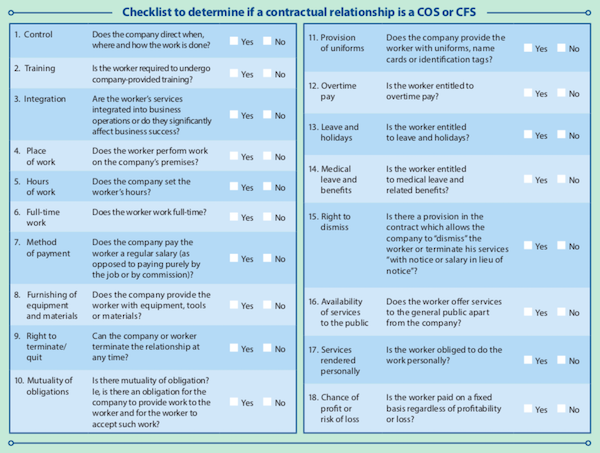In this article, we discuss the distinctions between employees and independent contractors (ICs), and how doctors who run their own practices as business owners and employers can avoid making classification mistakes that can result in serious legal implications under Singapore employment law, such as prosecutions under the Central Provident Fund (CPF) Act and the Employment Act (EA).
Contract of Service vs Contract for Service
Under Singapore law, there are several legal obligations which employers owe to their employees under the EA and the CPF Act. Conversely, these obligations are not owed to ICs. For instance, employees are legally entitled to receive:
- Payment of CPF contributions;
- Overtime payment;
- Minimum number of leave days and medical leave; and
-
Minimum notice period.
The failure to pay CPF contributions is probably the most common reason why employers are investigated and subsequently prosecuted by the CPF Board. Business owners and employers could end up facing substantial consequences such as late payment interest charged at 18% per annum, fines of up to $5,000 per offence and even jail for repeat offenders. To put the quantum of fines in perspective, the CPF Board considers each monthly failure to pay CPF contributions as a separate offence. Accordingly, assuming that the employer is fined $2,000 for each offence (a fine on the lower end of the scale), the employer would end up facing a substantial fine of say $48,000 if we apply an average 24-month liability period given that the CPF Board will hold the employer liable for the entire period for which CPF contributions would have been payable. If one were to assume a three-worker scenario, the employer's or business owner's liability would quickly balloon up to a mammoth sum of nearly $150,000 – not yet including the late payment interest.
It is therefore clear that this seemingly innocuous legal distinction of a worker's status can have drastic consequences. The question that logically follows is therefore: what distinguishes an employee from an IC? This distinction is especially crucial for clinics that employ locum doctors on an IC basis who, as explained below, could either be arguably seen as a part-time employee or IC depending on the fact-sensitive arrangement between them and the clinic.
Under the EA and CPF Act, employees are defined as persons who have entered into work under a "contract of service" (COS). A COS is in contradistinction to a "contract for service" (CFS), pursuant to which ICs are engaged. Ascertaining the nature of the relationship is a highly factual inquiry and if the relationship is determined to be a COS, then regardless of what was intended by the employer or employee, or the characterisation of the documents governing the relationship, the employer may still be found to be in breach of its legal obligations. In essence, when determining a relationship, the authorities examine the substance of the relationship, rather than its form. The mere labelling of a contract as an "Independent Contractor Agreement" will not save it from judicial scrutiny.
One of the main considerations in determining the nature of the relationship would be the level of control that the company or employer has over the worker. In a COS, the employer generally exercises a significant degree of control over the employee and the employee is bound to obey all instructions reasonably given to him. On the other hand, in a CFS, the company exercises little to no control over the manner in which the IC carries out the work. In a CFS, the IC is also entitled to reject the assignment brief, unlike an employee who cannot refuse to perform work assigned to him within his work scope. The more control an employer exercises over how, when, where and by whom the work is performed, the more likely that the worker will be deemed to be an employee.
Ultimately, every case will turn on its facts but nonetheless, the checklist provided on the next page can help you determine whether the contractual relationship is a COS or a CFS, as a guideline. The more "yes" ticks there are, the higher the likelihood that the relationship will be deemed to be that of an employer-employee.
Therefore, if a locum doctor is only called in to the clinic to fill in for an emergency as a one-off assignment, it is unlikely that any employment relationship will be inferred based on the above test. If, however, the locum doctor has an arrangement with the clinic to come in for five hours a day twice a week, the law may infer an employment relationship depending on the terms of engagement.
On a separate but related note, labelling an agreement as a "Part-Time/Contract/Daily-rated" engagement will also not negate the requirement to pay CPF. This is because the CPF Act clearly stipulates that CPF contributions are payable so long as a worker earns more than $50 a month.
Clear legal documentation is critical
In order to avoid any adverse legal repercussions, doctor-business owners should ensure that their legal documentation and substantive practices are robust enough to withstand scrutiny from the Ministry of Manpower and the Courts. Employment and IC agreements should be drafted clearly and with caution, especially if the intention is for the relationship to be one of IC-client.
If the intention is for the relationship to be that of employer-employee, then the onus is on the employer to ensure that all legal and regulatory requirements are complied with as ignorance of the law is no excuse. This is especially crucial in light of the proposed amendments to the EA in 2018 which would extend its coverage of employee protection and employee benefits to professionals, managers, executives and technicians. Doctor-business owners should always seek legal advice and clarification when unclear of how best to structure or classify their various working relationships.
